This post may contain affiliate links. Please read our disclosure policy.
Crispy breaded pork cutlets are perfectly seasoned in this easy Pork Katsu recipe. This delicious pork dinner is a must for a flavorful yet quick weeknight meal!
If you’re craving a different spin on pork, make this char siu recipe for another tasty option!
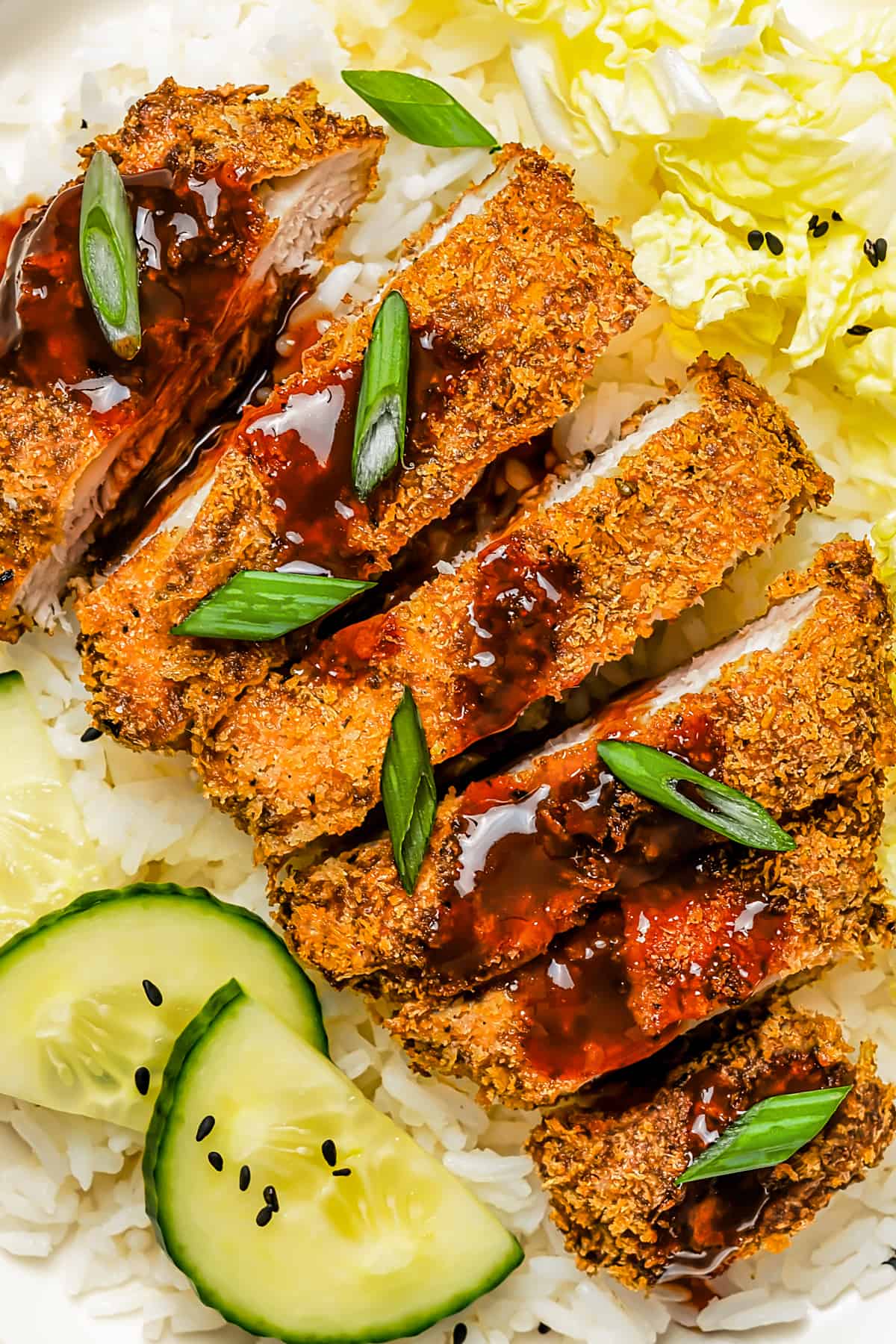
If there’s one thing my family can’t get enough of, it’s a good pork recipe. Whether it’s a juicy pork loin recipe, rich and creamy mushroom pork chops, or perfectly baked bone-in pork chops, we love them all! And when it comes to exploring new flavors, we’re always up for a twist—like this Japanese-inspired Tonkatsu.
If you like Japanese food – or Hawaiian food! Katsu is popular there, too – let me just say you’ve got to try this recipe. It takes basic boneless pork cutlets to a whole new delicious level. With crunchy breading and flavor-packed katsu sauce, you’ll never pass over those thin little pork chops at the grocery store again. Plus, this dish is super quick and easy to make. If you have a kitchen thermometer or a deep fryer, it’s even easier! Or, you can totally skip the deep frying process and use your air fryer instead.
What Is Katsu?
There are many kinds of katsu out there because katsu means meat that’s been thinly cut, breaded, and fried. Katsu is almost always served cut into slices so you can see both the crispy exterior and the juicy interior. It’s also served with katsu sauce, a Japanese version of barbecue. It’s tangy, sweet and has oyster sauce for a deep, umami flavor that’ll keep you coming back for more.
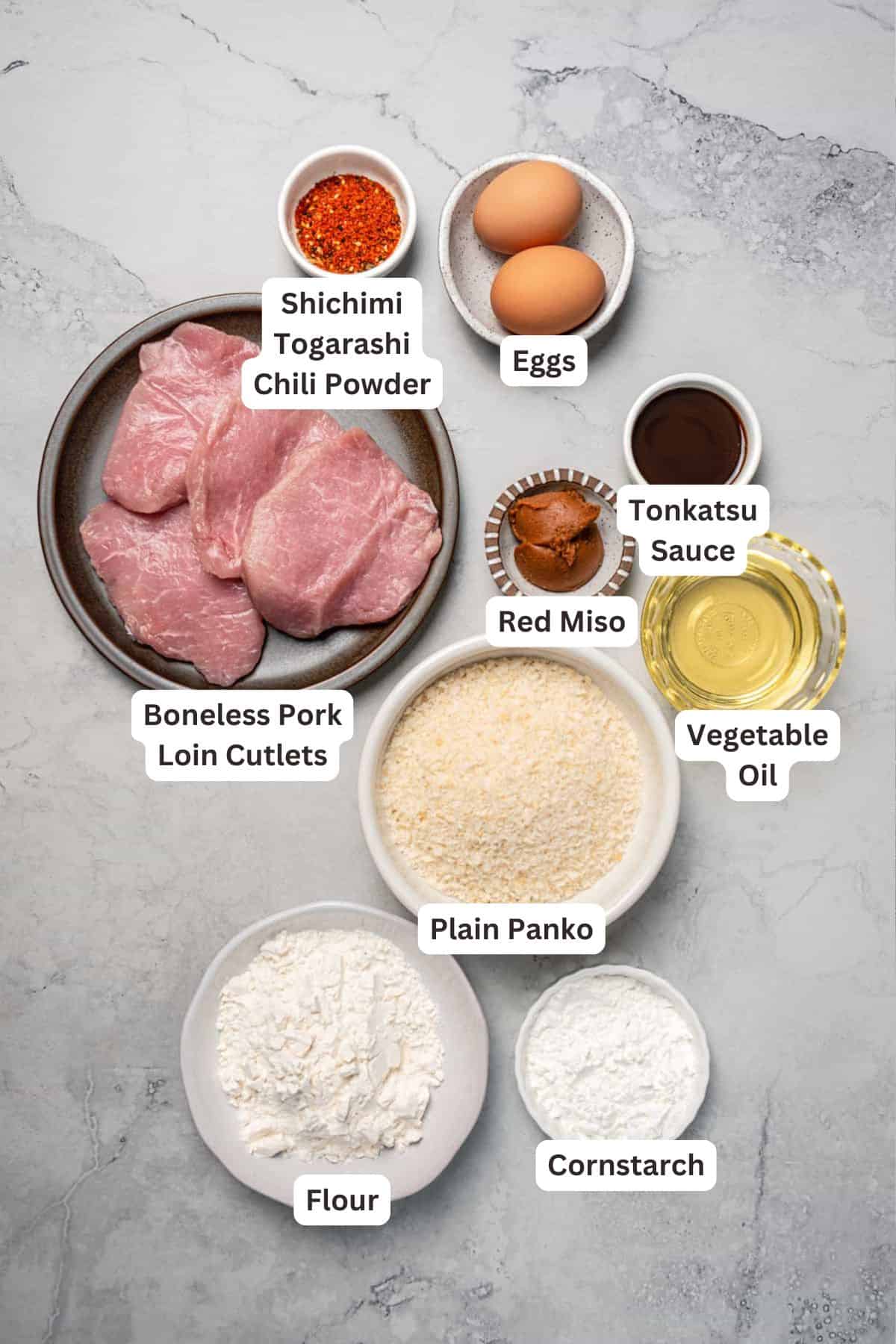
Recipe Ingredients
This tonkatsu recipe is made with a mix of simple ingredients and a few special touches that bring authentic flavor to the dish. Below are some notes on what you’ll need, but for the full ingredients amounts and directions, please scroll down to the recipe card.
- Pork Cutlets: If you don’t see pork cutlets at the store, get thick, boneless chops and cut them in half, crosswise, to make thin cutlets.
- Panko: Plain panko works fine, or you can use the pork rind panko or gluten-free panko.
- Shichimi Togarashi Chili Powder: Also known as Japanese seven spice, this flavorful spice mixture is made with dried citrus, sesame seeds, dried chili, furikake, and more.
- Eggs: Large, whole eggs, beaten.
- Red Miso: Beaten into the eggs for extra flavor.
- Flour and Cornstarch: Mixed together, these help the egg and panko form a stable breading.
- Vegetable Oil: Or another high-heat oil, for frying.
How to Make Pork Katsu
To make this easy Tonkatsu recipe, follow the step-by-step directions below. Start by pounding those pork cutlets nice and thin. Set up your breading station, and get that oil hot for perfectly crispy, golden-brown goodness.
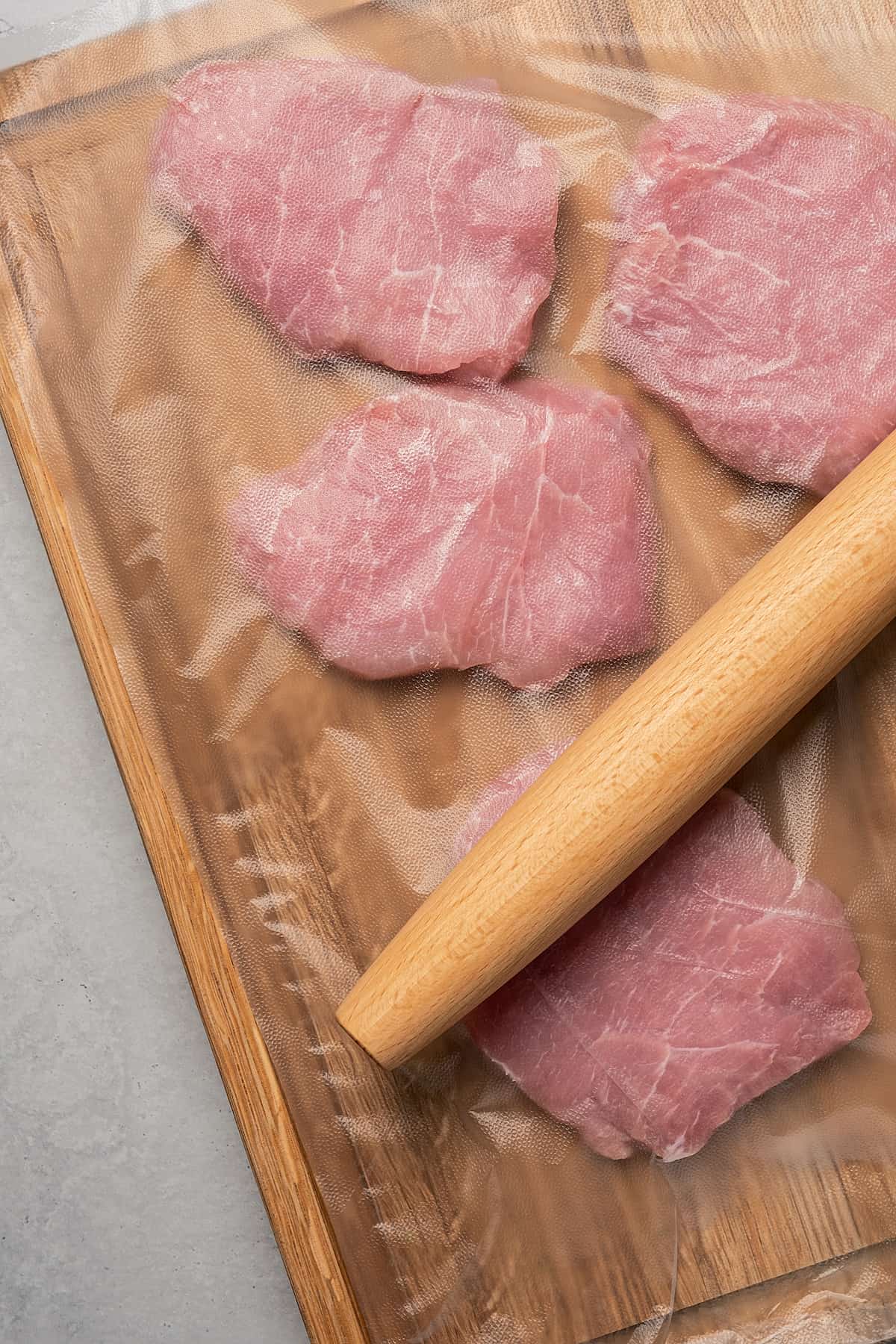

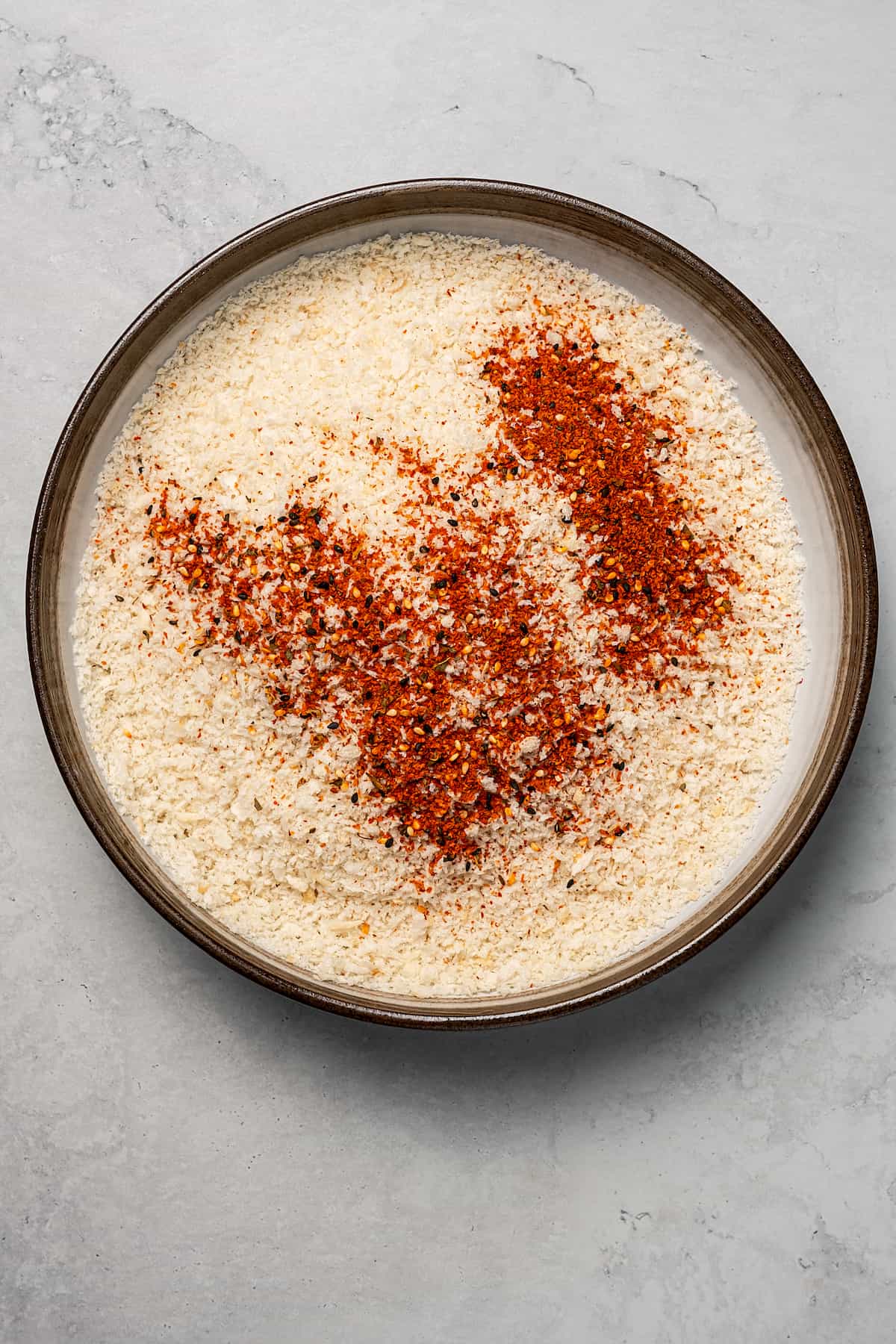
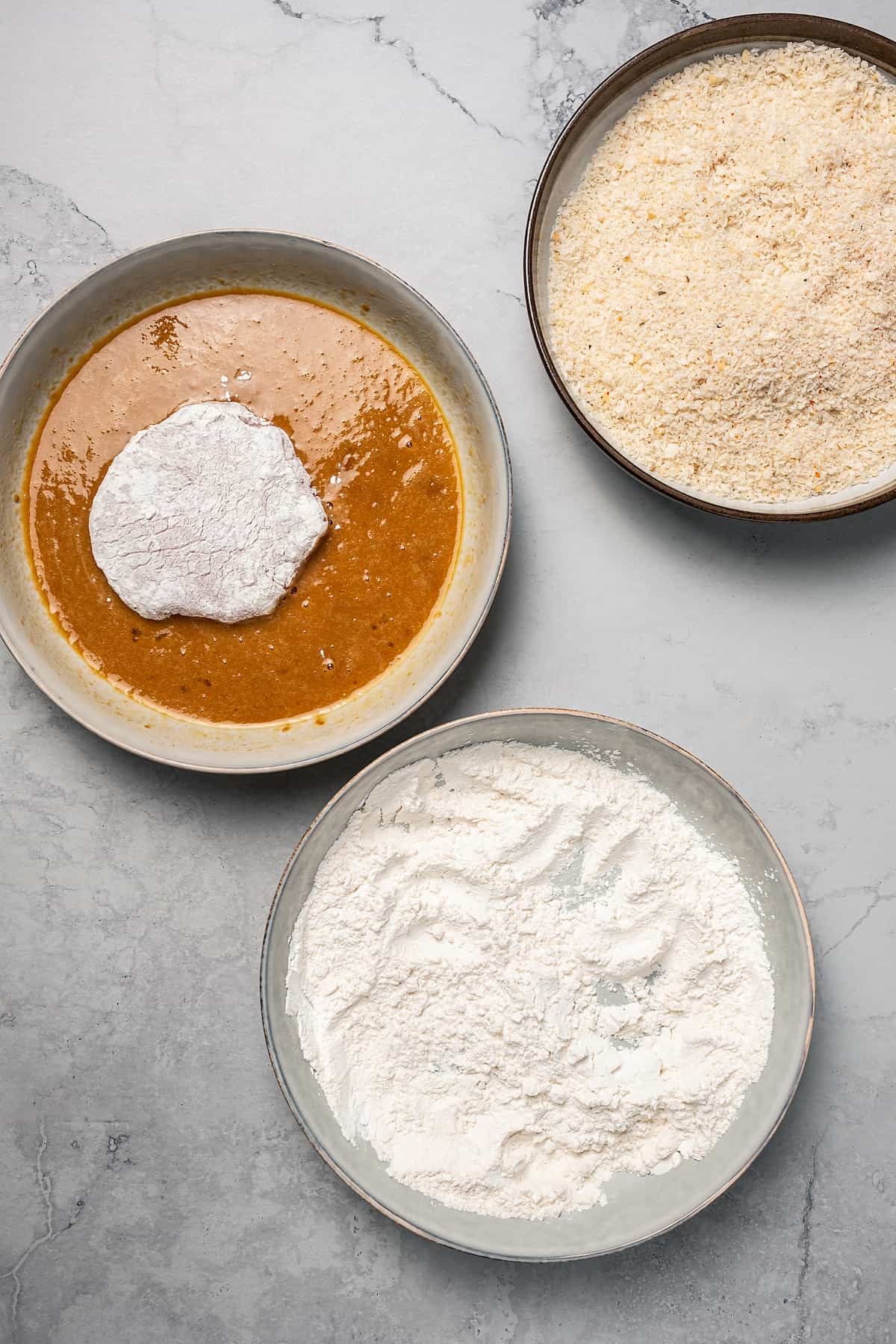

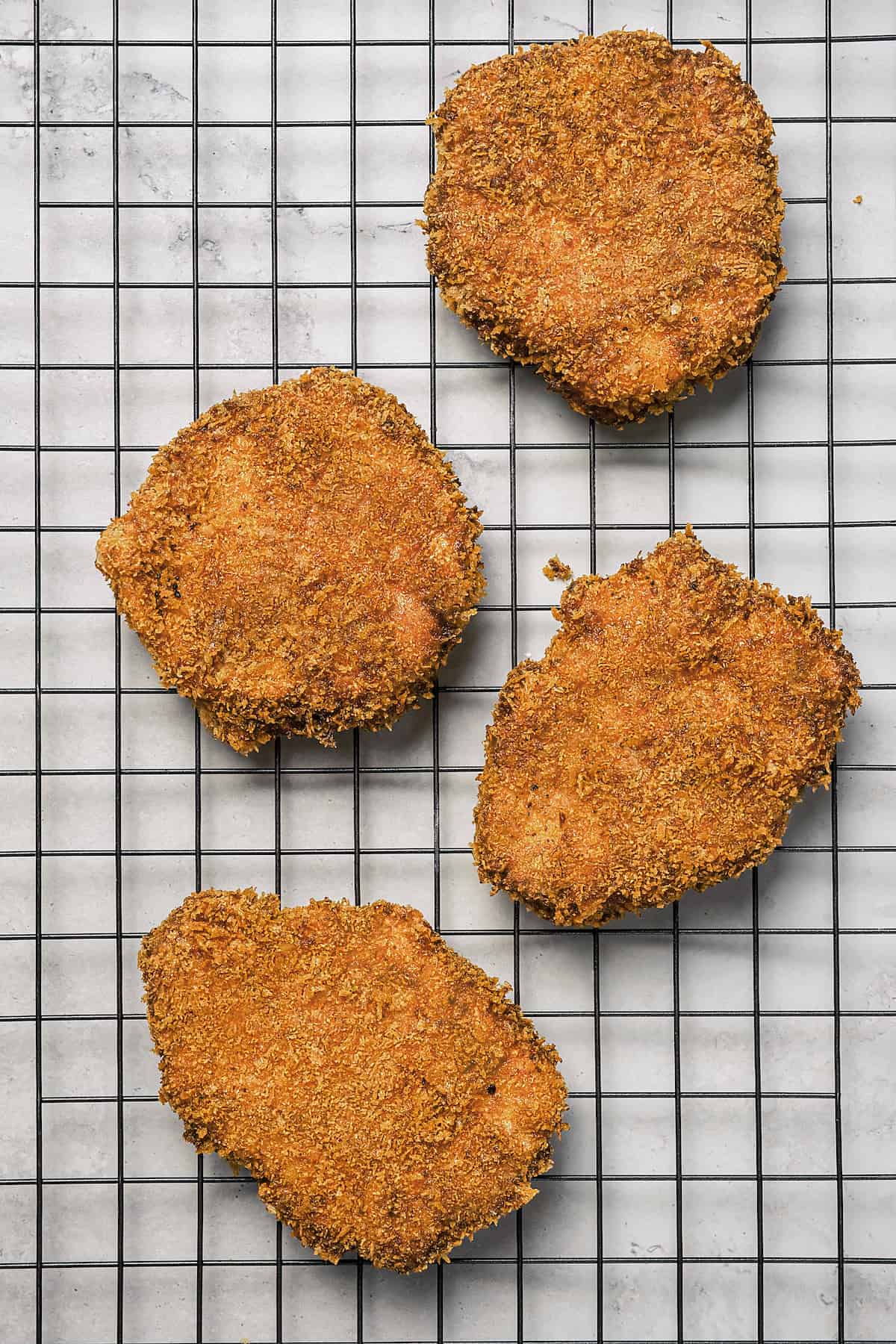
- Prep the pork chops. Place the pork cutlets on a cutting board, put plastic wrap over them, and use a meat mallet, rolling pin, or the bottom of a saucepan to pound them to a 1/2 inch thickness.
- Prep the breading station. In a shallow dish, beat the eggs and miso until the miso is dissolved. Combine the panko and shichimi togarashi in a separate shallow dish. Finally, mix the flour and cornstarch in a third shallow dish. Set a clean, dry baking sheet or larger platter nearby.
- Heat the Oil and Bread the Pork. Add vegetable oil to a pot over medium heat and heat it up to 350°F. Dredge the pork cutlets in the flour mixture to coat. Then dip them in the egg mixture, and finally, the panko, pressing the crumbs firmly to help them stick. Place the breaded cutlets on your clean baking sheet or platter as you go.
- Fry. If you’re not using a candy or kitchen thermometer, check the oil’s temperature by dipping a small corner of one of the cutlets into the oil. If it sizzles immediately, you can lower the whole cutlet into the oil. If it doesn’t sizzle, turn up the heat, wait a couple of minutes, and try again. Once the oil is hot enough, fry each cutlet for a few minutes on each side or until cooked through.
- Enjoy! Cool the pork katsu on a wire rack or a clean dish lined with paper towels. After they cool for a minute or two, use a sharp knife to slice them into one-inch strips. Drizzle with katsu sauce, sprinkle with salt, and serve.
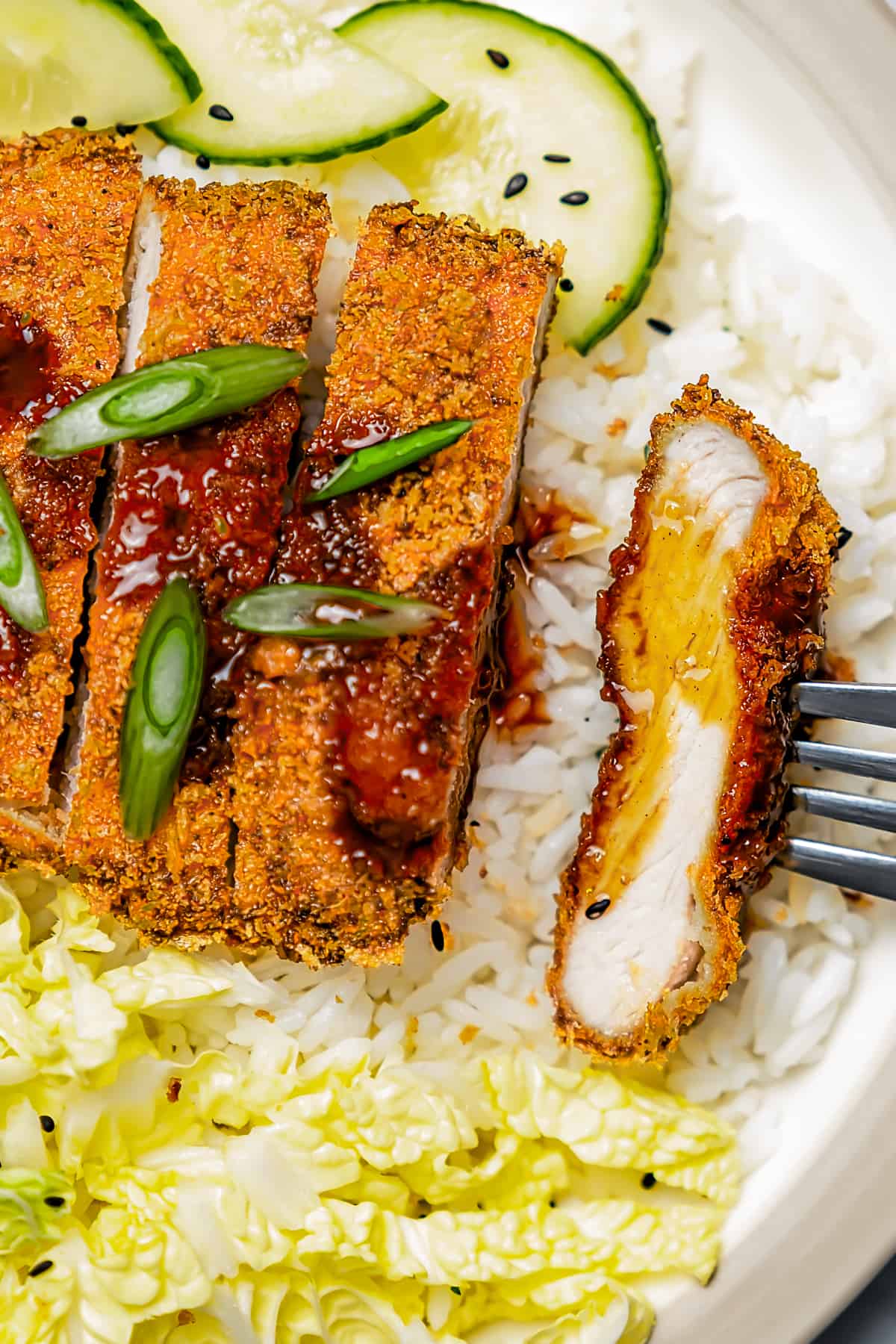
Recipe Tips And Variations
- Shichimi Togarashi Chili Powder: If you can’t find this spice mix at your local grocery store, try ordering online, or make a quick substitute: orange zest, crushed red pepper flakes, finely chopped nori, some ginger, and some sesame seeds. One taste, and you’ll want to shake this into every dish you make!
- Red Miso: Substitute any kind of miso paste here, or leave it out if you prefer.
- Air Fryer Method: To make these in the air fryer, follow the prep and breading steps, but don’t heat up oil on the stove. Instead, follow my air fryer pork chops recipe and preheat your air fryer to 400°F. Arrange the breaded pork cutlets in the air fryer basket in a single layer, not touching (you may have to work in batches). Spritz with non-aerosol cooking oil, and air-fry for 5 minutes. Flip, spray again, and air-fry for 3 to 5 minutes more, or until the internal temperature of the pork registers at 145˚F.
- Katsu Curry: Serve your pork katsu with Japanese curry sauce instead of katsu sauce; it’s great over rice.
- Katsu Sando: “Katsu sando” means cutlet sandwich. A warm, fresh pork katsu on your favorite sandwich bread? It’s a yes for me! Bonus points if you add katsu sauce, mayonnaise, or another tasty sauce.
- Chicken Katsu: You can also make this recipe for katsu with chicken cutlets instead of pork. Easy and tasty!
What To Serve With Tonkatsu
You can serve these cutlets in many different ways. As you can imagine, pork katsu is excellent with this cabbage cucumber salad. For a Hawaiian Katsu, place the slices of katsu over a bed of white rice and drizzle with katsu sauce.
Add a side salad like very berry avocado salad and this potluck pasta salad to the menu! Also, this coconut lime cauliflower rice would be amazing!
How to Store & Reheat Leftovers
- You can store pork katsu in your refrigerator for 3 to 4 days. Cool it down, pop it into a food storage bag or airtight container, and refrigerate. You can also freeze them for 2 to 3 months. Thaw before reheating.
- To reheat, use your oven (350°F) or arrange the katsu in a skillet over medium heat. You can also reheat it in the air fryer. Don’t use the microwave, or the pork katsu will be soggy.
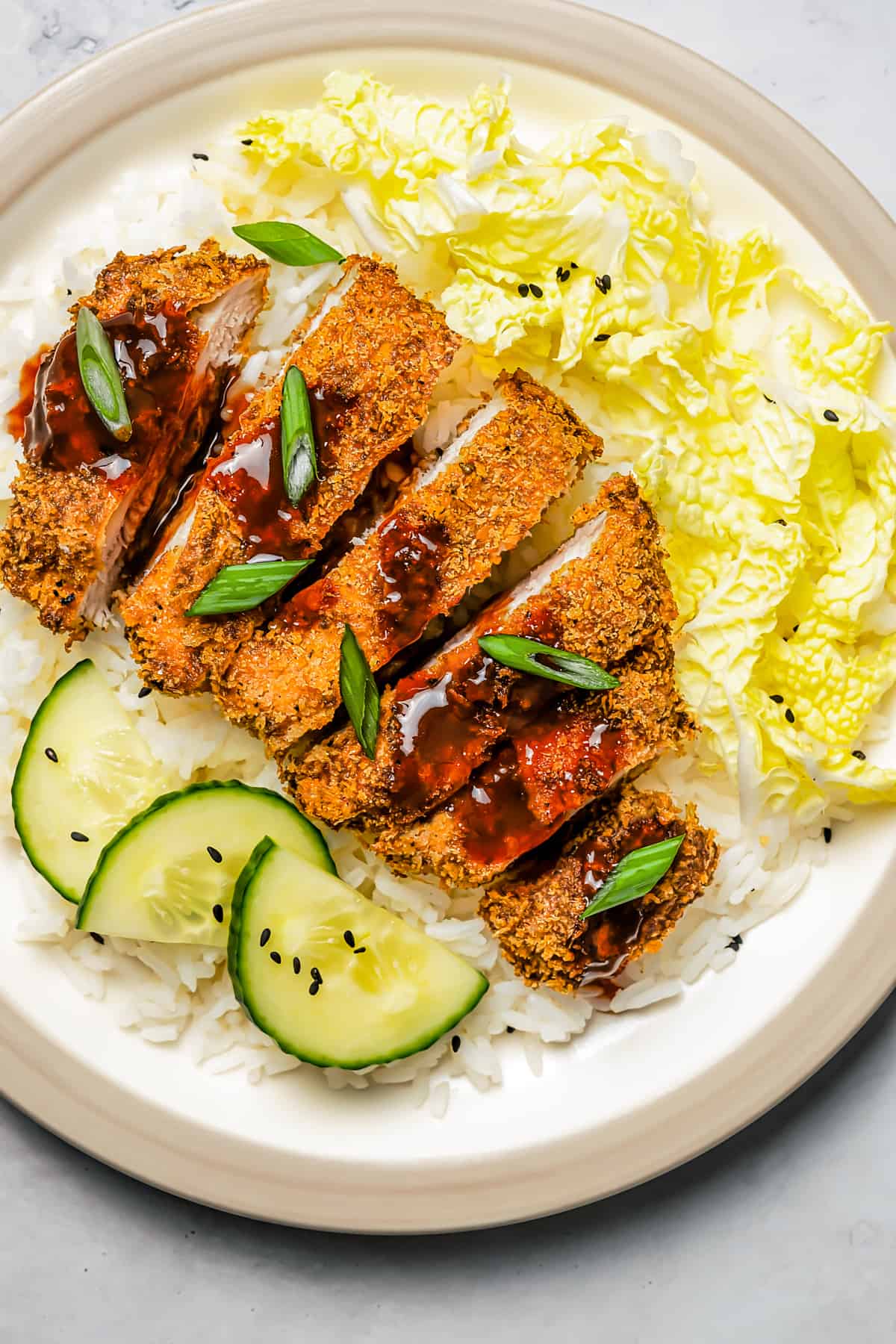
More Japanese Recipes
- Japanese Kani Salad
- One Pot Easy Teriyaki Chicken Recipe
- Easy Soba Noodle Soup Recipe
- Maki Rolls
- Teriyaki Noodles Recipe
Pin this now to find it later
Pin It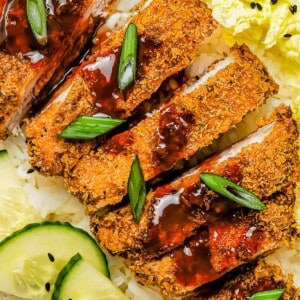
Pork Katsu
Ingredients
- 4 boneless pork loin cutlets, 1/2-inch thick
- 3 cups plain panko
- 2 teaspoons shichimi togarashi chili powder
- 2 eggs
- 2 tablespoons red miso
- ¾ cup all-purpose flour
- 3 tablespoons cornstarch
- Tonkatsu sauce
- salt, to taste
- vegetable oil, for frying
Instructions
- Flatten the cutlets: Place the cutlets on a chopping board. Place some parchment paper or plastic wrap over them. Use a meat mallet or rolling pin to pound them down to 1/2" thickness.
- Make the egg mixture: In a small bowl, crack the eggs and whisk until well combined. Add the red miso paste and stir until it has completely dissolved. Set it aside.
- Make the spicy panko: In a large plate or bowl, whisk together the plain panko with 2 teaspoons of the shichimi togarashi chili powder.
- Mix the flour: In a separate bowl, whisk together the all-purpose flour and cornstarch. Set it aside.
- Dredge the cutlets: Place the pork cutlets in the flour mixture. Dredge them with the flour until they're completely coated.
- Add vegetable oil to a large skillet and set it over medium heat. Let the oil heat up to 350˚F. You can use a kitchen thermometer to test the temperature. If you don't have one, you can check if it's hot enough in the next couple of steps.
- Coat them with miso-egg: Place the dredged cutlets into the miso-egg mixture. Coat them entirely and then dredge them in the spicy panko. Press the panko onto the cutlets so it sticks on all sides.
- Fry them: If you don't have a kitchen thermometer, test the oil's temperature by dipping a small corner of one of the cutlets into the oil. It's ready if it sizzles right away. If not, increase the flame. The size of the bubbles should be big when you add the pork. Once the oil is hot enough, gently lower one pork cutlet into the oil. Let it fry for 3 to 4 minutes or until golden brown; flip and continue to cook for 3 more minutes or until cooked through. Pork is cooked through when its internal temperature registers at 145˚F. Continue to cook the rest of the cutlets, one by one. Important: Using a fine mesh strainer, remove the leftover fried/burnt crumbs from the oil before adding the next cutlet to the cooking oil.
- Cool and slice: Remove the pork cutlets from the oil and set them on a wire rack to cool; let them cool for 3 to 4 minutes, and then slice the cutlets into 1"-wide strips.
- Drizzle with tonkatsu sauce and sprinkle more salt to taste if needed. Serve.
Notes
- Pork Loin Cutlets: The term cutlet refers to a boneless, thin cut of meat – chicken, veal, pork – that cooks quickly and is usually pan-fried. Most cutlets are made by pounding the meat to an even thinness and are often dusted with flour or coated in breadcrumbs before cooking.
- Panko: I used plain panko (Japanese) breadcrumbs for this katsu recipe, but you can also use gluten-free panko, regular breadcrumbs (though katsu is strictly made with panko crumbs), or low-carb pork rind crumbs.
- Shichimi Togarashi Chili Powder is also known as Japanese Seven Spice. Shichimi togarashi’s base is chili pepper, and cayenne pepper or red pepper flakes are suitable subs. You can also make your own quick substitute: mix together some orange zest, crushed red pepper flakes, finely chopped nori, some ginger, and some sesame seeds.
- Using a fine mesh strainer, remove the leftover fried crumbs from the cooking oil before adding the next cutlet to the pan.
Nutrition
Nutritional info is an estimate and provided as courtesy. Values may vary according to the ingredients and tools used. Please use your preferred nutritional calculator for more detailed info.









This pork katsu turns out perfectly; as good as all the restaurant versions we’ve tried. Blending the red miso paste with the beaten egg took a very long time however, and I was wondering if there is a work around? Plus, the miso paste has to be refrigerated after opening, which means it will be cold and even harder to blend next time we make this recipe.
Hi!
SO happy you liked it! 🙂 To blend the cold paste, I whisk in a drizzle of hot water to dissolve it a little before continuing with the recipe.
Great recipe! Can red miso powder be used instead of the paste? I’m thinking the shelf life would be longer, an advantage since I don’t cook with miso often.
Hi! Red miso powder can be used as a substitute, but it’s harder to dissolve. Try mixing the powder with a little warm water to create a paste before adding it to the rest of the ingredients to help it blend more smoothly. The flavor might differ slightly, as the powder is often more concentrated, so you may want to start with a smaller amount and adjust to taste. If you’re looking for another option, soy sauce is a common substitute for miso paste.
This sounds really delicious ….and I would loved to have tried it….but unfortunately!…well not for me personally….I live in Mexico and can’t find all the products required for this dish!….I did find a recipe for the 7 spice…but even that I’m not sure I could find dried seaweed it requires!….Aw well…I may go shopping when I’m back in Canada!
I found all the unique ingredients on Amazon, including the red miso paste, the seasoning blend and the katsu sauce. 🥳
Yummerz! I just love everything about this katsu!
Thank YOU! I hope you enjoy it! 🙂
I love how tasty this is!! Thanks for the recipe!
I’m glad you enjoyed it! Thank YOU! 🙂
My new favorite dinner idea! It’s so easy to make but so delicious!
I hope you love it! Thank YOU! 🙂
This recipe is so easy to follow and turned out amazing!
That’s great! I’m very glad you enjoyed it! Thank YOU! 🙂
This looks so good! I’ve never heard of katsu before, but if there’s one thing I know, it’s that anything involving breaded, fried pork is going to be delicious. I’m making this one immediately.